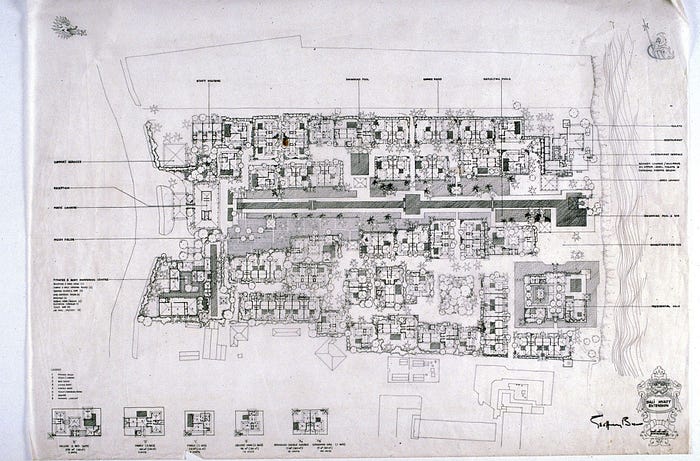Member-only story
A Quite Long History of Bali Hotel Architecture Part III: Made Wijaya and Bali After Donald Friend
After the completion of Bali Hyatt in 1974, the Batujimbar Estate project entered a vortex of rapid deterioration. Since then, almost no new plots have started, Wija’s interest has shifted to land sales rather than championing good designs, and Geoffrey Bawa won’t be involved with any other project in Bali until 1989 where Bali Hyatt commissioned him to design an extension on the north side of the existing Bali Hyatt complex.

The relationship Wija and Donald began continues to worsen, since all of the base capital are registered in the name of Wija, no instrument can justify the investment made by Donald. Under such psychological and financial pressures, Donald’s physical condition continued to deteriorate. Finally, in 1979, he decided to leave Bali and return to Australia. Before leaving, he sold his own Villa Batujimbar to Adrian Zecha.
Adrian Zecha began to look for a designer to renovate the entire building. The designer he chose was Ed Tuttle, an emerging designer he had just met recently. At that time, Ed Tuttle, who was not well-known, began to be interested in Southeast Asian culture at the end of 1960. He spent 7 years traveling in Southeast Asia. At that time, Adrian Zecha was quite a famous gentleman: he founded Orientations magazine and active in various social occasions One of Ed Tuttle’s assignments was to design Adrian Zecha’s residence in Hong Kong. The completed design made Adrian Zecha very satisfied.
In 1979, Ed Tuttle was assigned to complete the renovation of Villa Batujimbar. Ed Tuttle accomplished this task well. He used simple and modern techniques to make the entire interior look new. The renovation of the studio, guest rooms, and the addition of the swimming pool are all made by him. During this period, as Adrian Zecha transformed the hotel industry, he began to spend his time and energy in Regent Hotel & Resorts operations and development. Adrian Zecha then took Ed Tuttle into the hotel industry, although he had never independently completed a complete hotel project design work before.
